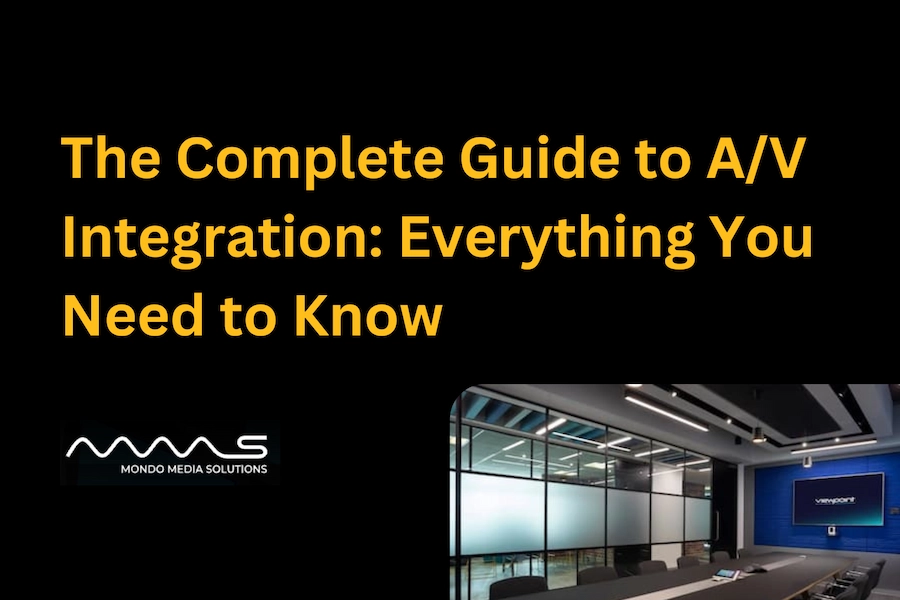Effective communication and collaboration are paramount for any high-performing business. Audio-Visual (AV) integration plays a crucial role in achieving these goals by seamlessly combining audio and video technologies to create cohesive systems. This comprehensive AV integration guide will walk you through the essentials, best practices, and solutions to help your business thrive.
What is AV Integration?
AV integration refers to the process of unifying various audio and visual components—such as microphones, speakers, displays, and control systems—into a cohesive setup that operates seamlessly. The goal is to enhance user experience by ensuring that all components work together efficiently, providing reliable and intuitive operation.
For instance, in a conference room setting, AV integration ensures that presentations, video conferencing, and sound systems function harmoniously, allowing for productive meetings without technical hiccups.
Benefits of AV Integration for Businesses
1. Enhanced Collaboration
Integrated AV systems facilitate real-time communication, enabling teams to collaborate effectively, regardless of their physical location. High-quality video conferencing and shared digital workspaces become more accessible, fostering a collaborative culture.
2. Streamlined Operations
By unifying AV components, businesses can automate routine tasks, reduce manual interventions, and minimize technical issues. This streamlining leads to more efficient operations and allows staff to focus on core responsibilities.
3. Scalability and Flexibility
Integrated systems are inherently scalable, accommodating business growth and evolving technological needs. Whether expanding to new locations or adopting emerging technologies, a unified AV infrastructure can adapt without significant overhauls.
4. Cost Savings
Consolidating AV systems reduces redundancy, lowers maintenance costs, and optimizes resource utilization. Over time, these savings contribute to a healthier bottom line and provide funds for further innovation.
AV Integration Best Practices
1. Assess Current Infrastructure
Begin by evaluating your existing AV setups to identify gaps, redundancies, and areas for improvement. This assessment provides a clear understanding of the integration scope and requirements.
2. Define Clear Objectives
Establish specific goals for the integration, such as improving communication, enhancing user experience, or supporting remote work. Clear objectives guide the integration process and help measure success.
3. Engage Professional AV Integration Services
Partnering with an experienced AV integration company ensures that the integration is executed efficiently and effectively. These professionals bring expertise in system design, installation, and maintenance, aligning the integration with your business needs.
4. Prioritize User Training
Ensure that employees are adequately trained to utilize the integrated systems. User proficiency maximizes the benefits of the integration and encourages adoption across the organization.
5. Plan for Future Expansion
Design the integrated systems with scalability in mind. This foresight allows for seamless incorporation of new technologies and supports business growth without significant disruptions.
AV Integration Solutions for Conference Rooms
Conference rooms are central to business operations, serving as hubs for meetings, presentations, and collaborative sessions. Implementing AV integration in these spaces enhances functionality and user experience.
- Video Conferencing Systems: High-definition cameras and microphones ensure clear communication during virtual meetings.
- Interactive Displays: Touchscreen displays facilitate dynamic presentations and real-time collaboration.
- Control Systems: Centralized control panels allow users to manage lighting, audio, and video settings effortlessly.
By integrating these components, businesses can create conference rooms that support efficient and effective meetings.
AV System Installation and Maintenance
Installation
Professional AV system installation is critical to ensure that all components function correctly and cohesively. This process involves careful planning, equipment selection, and configuration to meet the specific needs of the business.
Maintenance
Regular maintenance of AV systems is essential to sustain optimal performance. This includes routine inspections, software updates, and prompt resolution of any technical issues. Engaging AV integration services for ongoing support can help prevent downtime and extend the lifespan of your systems.
Choosing the Right AV Integration Company
Selecting a reputable AV integration company is crucial for the success of your integration project. Consider the following factors:
- Experience: Look for companies with a proven track record in AV integration services.
- Customization: Ensure they can tailor solutions to meet your specific business needs.
- Support: Opt for providers that offer comprehensive support, including training and maintenance.
Collaborating with the right AV integrator can make a significant difference in the effectiveness and longevity of your AV systems.
Conclusion
Investing in AV integration is a strategic move that can transform your business operations. By following this AV integration guide and engaging professional services, you can create a seamless and efficient AV environment that supports collaboration, enhances productivity, and positions your business for future success.
